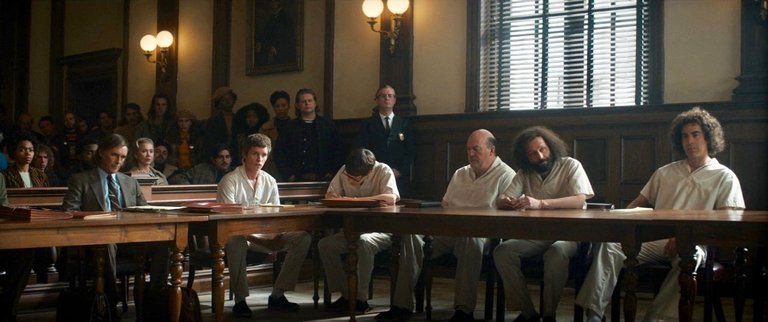
Scene from the movie "The Trial of the Chicago 7", by Aaron Sorkin. Fuente
En una publicación anterior revisamos la película El Juicio de los 7 de Chicago (2020) y dimos un vistazo a la historia detrás de uno de los procesos judiciales más controversiales y criticados en los Estados Unidos. El marco de esa batalla legal fue el caldeado ambiente de finales de los 60. Las protestas contra la Guerra de Vietnam, las luchas por el reconocimiento de los Derechos Civiles de los afroamericanos, el auge del rock, la psicodelia, la descolonización africana, el Mayo de París, entre otros procesos políticos y socioculturales, produjeron en la juventud la sensación de “todo era posible” y sustentaron las convicciones de los protagonistas en la historia que Sorkin llevó a la pantalla grande. ¿Pero qué pasó después? ¿Qué fue de las vidas de quienes se enfrentaron en ese tribunal? Así como, durante el juicio, fueron referentes de la contracultura emergente, ¿fueron sus historias personales también espejos de una sociedad que parecía marchar en dirección opuesta a sus ideales? Les invito a que lo averigüemos en esta resumida revisión a los epílogos de sus historias, algunas de las cuales resultaron ser más surrealistas y sorprendentes que el propio juicio. Saludos, Hiveanos.
In a previous post we reviewed the film The Trial of the Chicago 7 (2020) and took a look at the history behind one of the most controversial and criticized court cases in the United States. The context of that legal battle was the heated atmosphere of the late 1960s. The protests against the Vietnam War, the fights for the recognition of the Civil Rights of the Afro-American people, the rise of rock, psychedelia, African decolonization, the May of Paris, among other political and socio-cultural processes, produced in the youth the feeling that "anything was possible" and sustained the convictions of the protagonists in the story that Sorkin took to the big screen. But what happened next? What became of the lives of those who confronted each other in that courtroom? Just as, during the trial, they were references of the emerging counterculture, were their personal stories also mirrors of a society that seemed to march in the opposite direction to its ideals? I invite you to find out in this brief review of the epilogues to their stories, some of which turned out to be more surreal and surprising than the trial itself. Greetings, Hiveans.

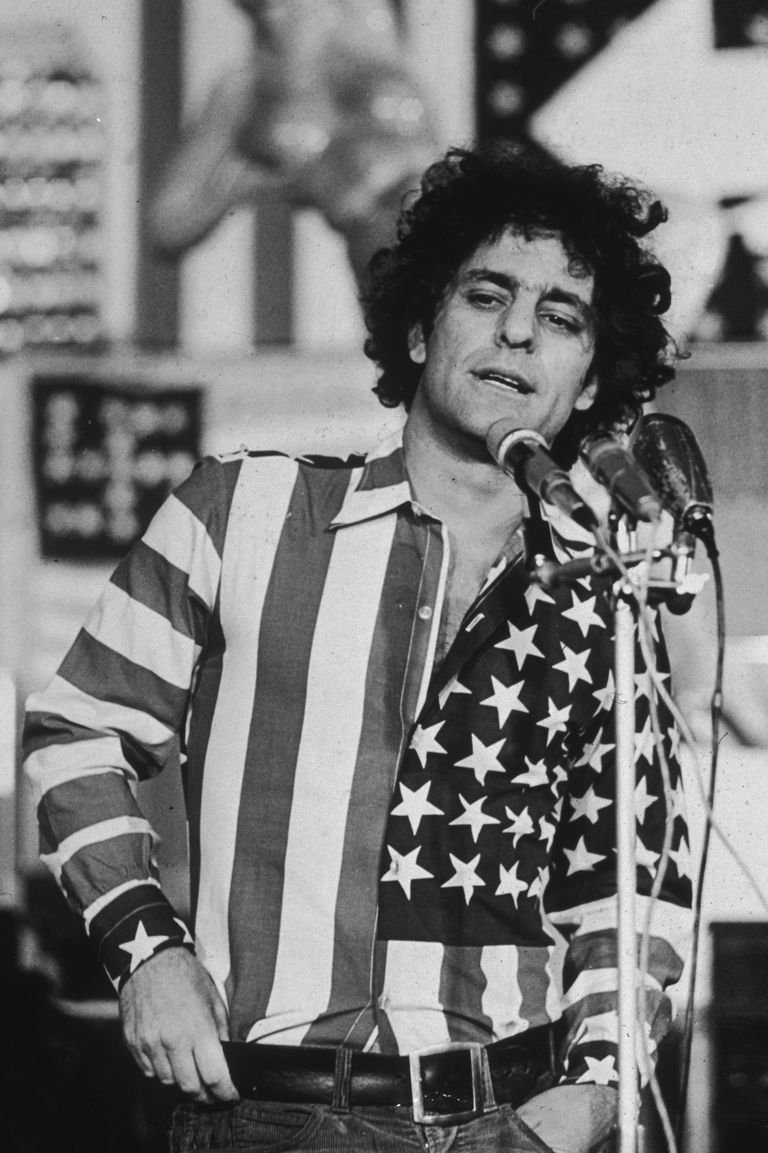 Fuente
FuenteAbbie Hoffman
Abbie Hoffman, tal vez la cara más mediática, controversial y recordada del juicio, continuó como activista político y se convirtió en un referente de la izquierda radical en los Estados Unidos. En 1971, publicó Roba este libro, una suerte de guía para la organización, la lucha contra el sistema y vivir de gratis, utilizando tácticas de guerrilla, para derribar el capitalismo. Aunque fue prohibido en Canadá y muchas librerías se negaron a comercializarlo porque la gente solía seguir el consejo del título, el libro consiguió vender 250 mil ejemplares. Publicó también Para América con amor y ¡Vota!, este último en coautoría con Jerry Rubin.
En 1973 enfrentó nuevos problemas con la ley. Esta vez acusado de intentar vender cocaína. Hoffman se defendió señalando que agentes encubiertos de la policía lo habían inducido a un negocio de drogas y le habían “sembrado” la cocaína en su oficina (esto lo sostuvo hasta el final). Huyó mientras estaba en libertad condicional, se operó la nariz para cambiar de aspecto y se refugió en Montreal y Ciudad de México. Luego se instaló en el pequeño pueblo de Finneview, Nueva York, bajo la identidad de Barry Freed, nombre con el que participó en la organización de una campaña ambientalista a favor del río Saint Lawrence. En 1980 se entregó a las autoridades y fue condenado a un año de prisión.
Tras su sentencia, siguió ejerciendo un periodismo radical que lo llevó a publicar con cierta frecuencia en revistas como Ramparts y Playboy. En esta última, su artículo sobre las conexiones y juego sucio en el “October Surprise”, despertó interés y sospechas en buena parte de los lectores. Apareció (como él mismo) en la película Nacido el 4 de julio, de Oliver Stone. Su vida fue llevada al cine en el 2000, bajo el título Roba esta película.
Hoffman sufría de trastorno bipolar y terminó quitándose la vida, en abril 1989, tomando al menos 200 pastillas de Fenobarbital, su nota de suicidio decía: "Es demasiado tarde. No podemos ganar. Se han hecho demasiado poderosos". Más de mil personas asistieron a su funeral. Tenía 52 años y su archivo del FBI llenaba 13.262 páginas.
Abbie Hoffman
Abbie Hoffman, perhaps the most mediatic, controversial and remembered face of the trial, continued as a political activist and became a reference of the radical left in the United States. In 1971, he published Steal This Book, a kind of guide to organizing, fighting the system and living for free, using guerrilla tactics, to overthrow capitalism. Although it was banned in Canada and many bookstores refused to market it because people usually followed the advice in the title, the book managed to sell 250,000 copies. He also published To America with Love and Vote! the last one co-authored with Jerry Rubin.
In 1973 he faced new problems with the law. This time he was accused of trying to sell cocaine. Hoffman defended himself by pointing out that undercover police agents had induced him into a drug deal and had "planted" the cocaine in his office (he maintained this to the end). He fled while he was on parole, had a surgery on his nose to change his appearance, and took refuge in Montreal and Mexico City. He then settled in the small town of Finneview, New York, under the identity of Barry Freed, the name under which he participated in the organization of an environmental campaign in favor of the Saint Lawrence River. In 1980 he turned himself in to the authorities and was sentenced to one year in prison.
After his sentence, he continued to practice a radical journalism that led him to publish with some frequency in magazines such as Ramparts and Playboy. In the last one, his article about the connections and foul play in the "October Surprise", aroused interest and suspicion in a good part of the readers. He appeared (as himself) in Oliver Stone's film Born on July 4th. His life was made into a film in 2000, under the title Steal This Movie.
Hoffman suffered from bipolar disorder and ended up taking his own life, in April 1989, by taking at least 200 pills of Phenobarbital, his suicide note read: "It's too late. We can't win. They have become too powerful". More than 1,000 people attended his funeral. He was 52 years old and his FBI file filled 13,262 pages.

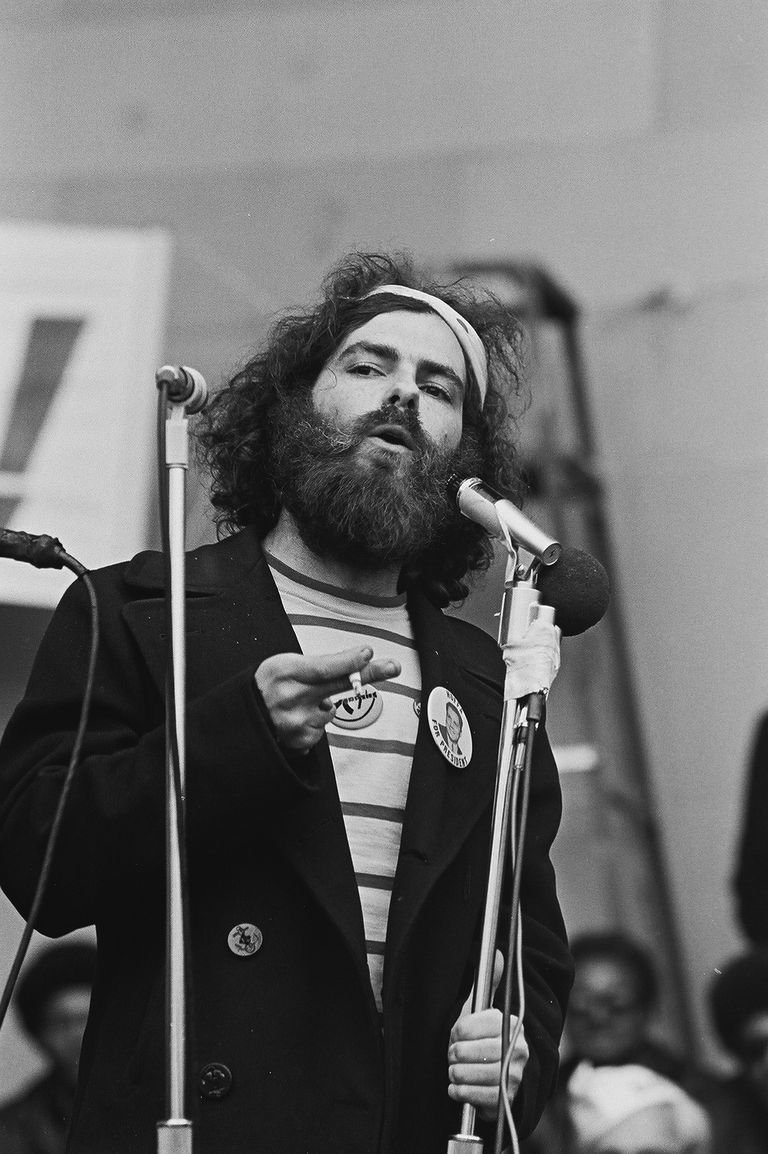 Fuente
FuenteJerry Rubin
En los años inmediatos al juicio, siguió participando en protestas y manifestaciones, resumiendo sus ideas en un libro que publicó en 1970, titulado ¡Hazlo! Escenarios de la Revolución. Pero tras la victoria republicana de Richard Nixon en las elecciones de 1972, Jerry Rubin tiró la toalla y se retiró de la política. Al poco tiempo se hizo inversor y hombre de negocios, destacando entre los primeros en apostar por Apple Computers. A finales de los 70, ya era millonario.
En 1980 lo encontramos como corredor de bolsa en la firma John Muir & Co, de Wall Street. "Sé que hoy en día puedo ser más efectivo usando traje y corbata y trabajando en Wall Street que bailando fuera de los muros del poder", dijo. Se cuenta que llegó a beber tanto jugo de zanahoria durante los ochenta que una de sus piernas se tornó color naranja.
Mantuvo su amistad con Abbie Hoffman, a pesar de lo distinto que resultaron sus caminos. Hicieron juntos una gira de debate nacional, donde discutieron sobre la forma que debería adoptar la revolución. Falleció a los 56 años, en noviembre de 1994, atropellado al intentar cruzar una carretera cerca de UCLA, en Los Ángeles.
Jerry Rubin
In the years immediately following the trial, he continued to participate in protests and demonstrations, summarizing his ideas in a book he published in 1970, entitled Do It! Scenarios of Revolution. But after Richard Nixon's Republican victory in the 1972 election, Jerry Rubin threw the towel in and retired from politics. Soon after, he became an investor and businessman, and was among the first to bet on Apple Computers. By the end of the 1970s, he was already a millionaire.
In 1980 we find him as a stockbroker at the Wall Street firm John Muir & Co. "I know that today I can be more effective wearing a suit and tie and working on Wall Street than dancing outside the walls of power," he said. It is said that he drank so much carrot juice during the 1980s that one of his legs turned orange.
He maintained his friendship with Abbie Hoffman, despite how different their paths turned out to be. They went on a national debate tour together, where they discussed what form the revolution should take. He died at the age of 56, in November 1994, run over while trying to cross a road near UCLA, in Los Angeles.

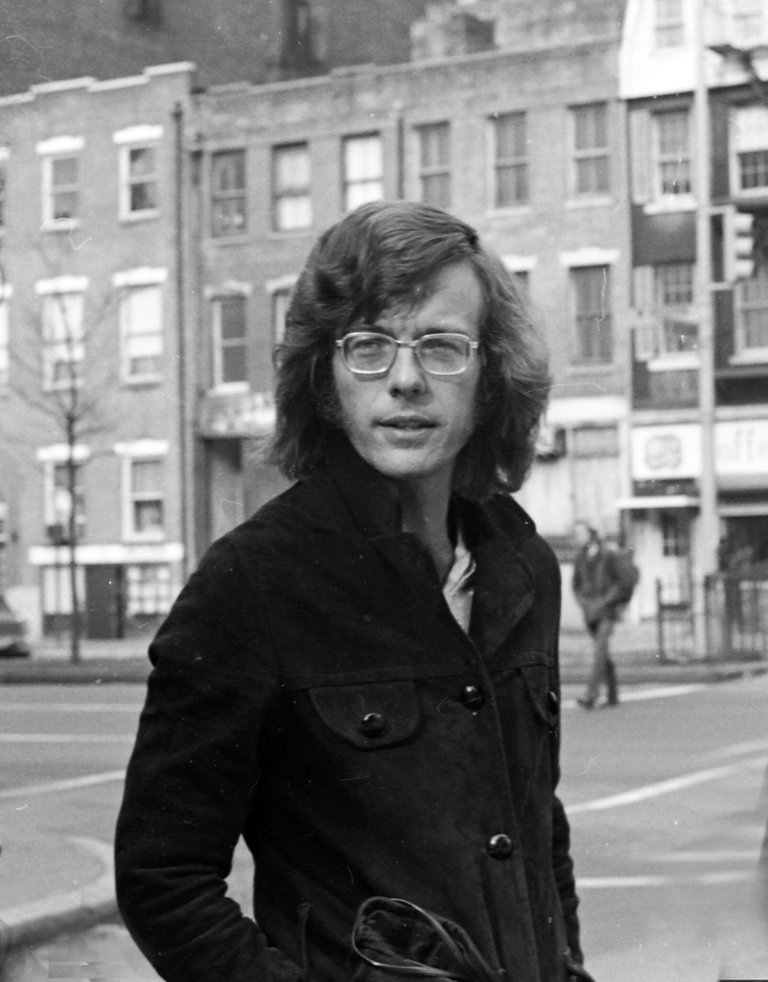 Fuente
FuenteRennie Davis
Después del juicio, Davis volvió al activismo antibélico, viajó por segunda vez a Hanoi y organizó la manifestación antibélica del Primero de Mayo de 1971, en Washington, que terminó con cerca de 13.000 arrestos. Se convirtió en una figura internacional del anti belicismo, llegando a tener buenas relaciones con John Lennon, quien le invitó en 1971 a una sesión de grabación para dar los últimos toques a su mundialmente famosa Imagine.
Pero en 1973 dio un giro que desconcertó a muchos de sus aliados y seguidores: Se convirtió en el principal promotor en Estados Unidos de Guru Maharaj Ji, un indio de 15 años que se anunciaba como "maestro perfecto", que sabía pilotar aviones y tenía millones de seguidores en todo el mundo. Sus amigos dijeron que Davis experimentó en esa época con drogas, entre ellas el LSD.
Davis pasó el resto de su carrera intentando combinar el radicalismo político de su juventud con una suerte de pastiche empresarial con ideas de la Nueva Era. Se convirtió en capitalista de riesgo y conferenciante de autoconciencia y meditación. Murió en, febrero de este año, a los 80 años, a causa de un linfoma descubierto dos semanas antes.
Rennie Davis
After the trial, Davis returned to anti-war activism, traveled a second time to Hanoi and organized an anti-war demonstration in Washington on May 1st 1971, which ended with nearly 13,000 arrests. He became an international anti-war figure, becoming on good terms with John Lennon, who invited him in 1971 to a recording session to put the finishing touches on his world-famous Imagine.
But in 1973 he took a turn that puzzled many of his allies and followers: He became the main promoter in the United States of Guru Maharaj Ji, a 15-year-old Indian who advertised himself as a "perfect master," who could fly airplanes and had millions of followers around the world. Friends said Davis experimented at the time with drugs, including LSD.
Davis spent the rest of his career trying to combine the political radicalism of his youth with a sort of entrepreneurial pastiche with New Age ideas. He became a venture capital investor and a speaker on self-awareness and meditation. He died in February of this year, at the age of 80, from a lymphoma discovered two weeks earlier.

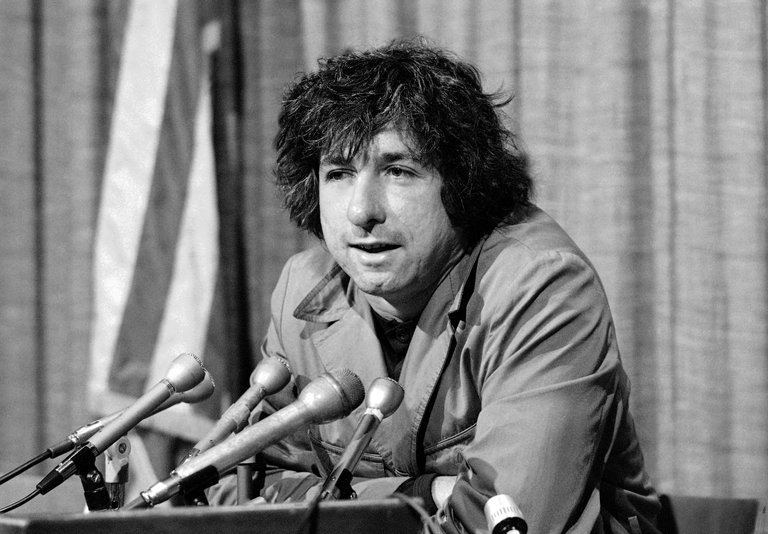 Fuente
FuenteTom Hayden
Hayden inició la década de los 70 consolidando su figura como líder pacifista. Realizó varios viajes al Sudeste Asiático con mucha cobertura mediática, entre ellos uno a Vietnam del Norte, en 1972, junto a la actriz Jane Fonda, con quien se casaría después. Su hijo, Troy Garity, interpretó a Hayden en Steal This Movie, la película biográfica sobre Abbie Hoffman, estrenada en el año 2000.
En 1976, Hayden desafió al Senador norteamericano por California, John V. Tunney, en la elección primaria del Partido Demócrata. Habiendo comenzado desde muy abajo, logró un sorprendente segundo lugar, muy cerca del primero. Integró la Cámara de Representantes (1982-1992) y el Senado del Estado de California (1992-2000). Llegó a ser candidato a Alcalde de la ciudad de Los Angeles, California, en 1997, siendo derrotado por Richard Riordan.
Se convirtió en un defensor de las políticas ecológicas y de los derechos de los animales. Tras su divorcio de Fonda, se casó dos veces más, impartió clases periódicamente en el Occidental College y en el Pitzer College, participó en las manifestaciones contra la OMC de 1999, en Seattle, donde dio un importante discurso. Ya en el siglo XXI, ejerció una dura oposición a la Guerra de Irak e integró el Comité Asesor del movimiento Progressive Democrats of America. Murió en 2016 por un derrame cerebral a los 76 años.
Tom Hayden
Hayden began the decade of the 70s consolidating his figure as a pacifist leader. He made several trips to Southeast Asia with a lot of media coverage, including one to North Vietnam in 1972, together with actress Jane Fonda, whom he would later marry. Their son, Troy Garity, played Hayden in Steal This Movie, the biopic about Abbie Hoffman, released in 2000.
In 1976, Hayden challenged California U.S. Senator John V. Tunney in the Democratic primary. Starting from the bottom, he came in a surprising second place, very close to first. He served in the House of Representatives (1982-1992) and the California State Senate (1992-2000). He went on to run for Mayor of the City of Los Angeles, California, in 1997, being defeated by Richard Riordan.
He became an advocate of ecological policies and animal rights. After his divorce from Fonda, he married twice more, taught periodically at Occidental College and Pitzer College, participated in the 1999 anti-WTO demonstrations in Seattle, where he gave a major speech. Already in the 21st century, he exercised a tough opposition to the Iraq War and was a member of the Advisory Committee of the Progressive Democrats of America movement. He died in 2016 from a stroke at the age of 76.
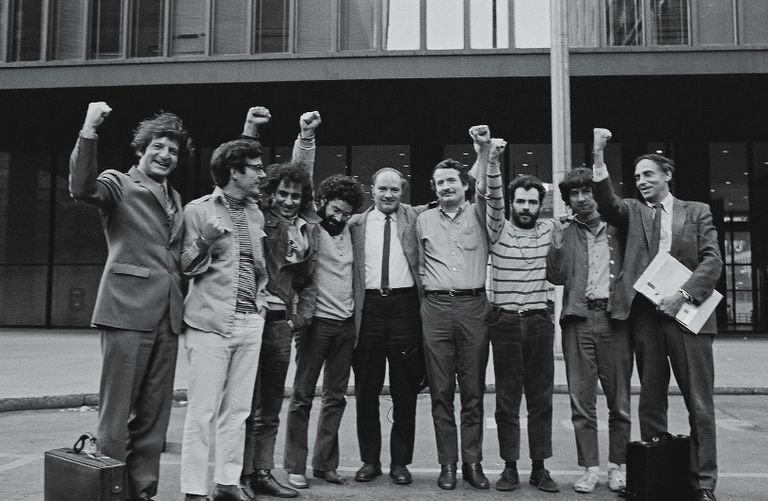
Hasta aquí la primera parte de nuestra investigación sobre el destino de los controvertidos protagonistas del famoso Juicio de los Siete de Chicago. En la parte final, revisaremos qué pasó con el resto de los acusados, así como el camino que siguieron Bobby Seale (para entonces líder de las Panteras Negras), los abogados y el muy criticado juez de la causa. ¡Hasta pronto, Hiveanos!.
So much for the first part of our investigation into the fate of the controversial protagonists of the famous Chicago Seven Trial. In the final part, we will review what happened to the rest of the defendants, as well as the path taken by Bobby Seale (by then leader of the Black Panthers), the lawyers and the much-criticized judge in the case. See you soon, Hiveans!.
